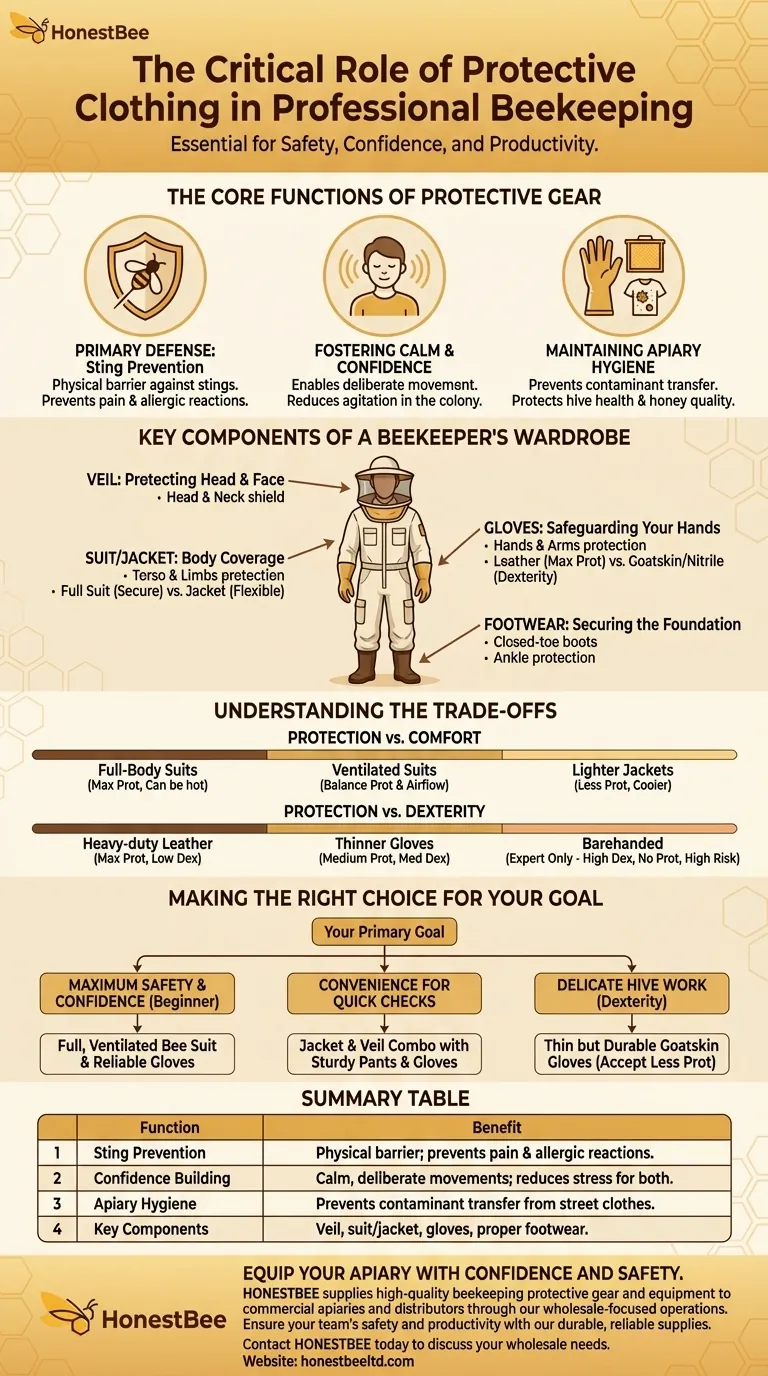At its core, protective clothing is the single most important tool for ensuring a safe and productive beekeeping experience. It serves as the essential barrier between you and the bees' natural defensive instinct—the sting. This protection allows you to work calmly and confidently, which is safer for you and less stressful for the bees.
The true value of beekeeping gear isn't just preventing pain; it's about managing fear. By removing the threat of stings, protective clothing enables a calm, focused, and respectful interaction with the hive, which is the foundation of successful beekeeping.

The Core Functions of Protective Gear
The Primary Defense: Sting Prevention
Honey bees sting when they perceive a threat to their colony. Protective clothing acts as a physical barrier, preventing a bee's stinger from reaching your skin.
This is the most obvious and critical function of the gear, safeguarding you from the pain and potential allergic reactions associated with bee stings.
Fostering Calm and Confidence
A beekeeper who is worried about being stung is often tense and makes sudden, jerky movements. This behavior can agitate a colony and increase defensive behavior.
By providing a sense of security, protective clothing allows you to move deliberately and gently. This calm demeanor is less threatening to the bees, leading to a more peaceful hive inspection for everyone involved.
Maintaining Apiary Hygiene
Your gear also plays a role in biosecurity. It helps prevent the transfer of contaminants from your street clothes into the hive, protecting the colony and the quality of your honey.
Key Components of a Beekeeper's Wardrobe
The Veil: Protecting Your Head and Face
The veil is non-negotiable. It shields your face, eyes, and neck, the areas most sensitive to stings and where a sting can be most dangerous.
Most veils are integrated into a helmet, jacket, or full suit to ensure no gaps are left for curious bees to explore.
The Suit or Jacket: Body Coverage
This is the main component covering your torso and limbs. New beekeepers must often decide between a full bee suit or just a jacket.
A full suit offers head-to-ankle protection and is the most secure option, especially for beginners. A jacket is easier to put on for quick inspections but must be paired with thick pants.
Gloves: Safeguarding Your Hands
Your hands are in the hive, manipulating frames and directly interacting with the bees. Gloves are essential for preventing stings on your hands and arms.
Materials range from thick leather for maximum protection to goatskin or even nitrile for increased dexterity, allowing for more delicate work.
Footwear: Securing the Foundation
Bees often crawl, and one of the easiest access points is an open pant leg. Closed-toe boots that rise above the ankle are crucial for completing your protective barrier.
Understanding the Trade-offs
Protection vs. Comfort
Thicker, full-body suits offer the best protection but can become extremely hot in warm weather. Modern ventilated suits are an excellent compromise, providing protection while allowing for significant airflow to keep you cool.
Protection vs. Dexterity
Heavy-duty leather gloves offer near-impenetrable defense but can make it difficult to feel what you're doing. Some experienced beekeepers may opt for thinner gloves or work barehanded to handle frames more delicately, but this requires significant experience and an understanding of the hive's temperament.
Forgoing Gear: A Choice for Experts
As beekeepers gain years of experience, they learn to read a colony's mood. Some may choose to work without full gear on calm days with a gentle hive. This is a calculated risk based on expertise and is not recommended for beginners.
Making the Right Choice for Your Goal
Ultimately, your choice of gear should match your comfort level and beekeeping goals.
- If your primary focus is maximum safety and confidence as a beginner: Invest in a full, high-quality ventilated bee suit and reliable gloves.
- If your primary focus is convenience for quick hive checks: A jacket and veil combo paired with sturdy pants and gloves can be a flexible and efficient option.
- If your primary focus is delicate hive work requiring dexterity: Consider thin but durable goatskin gloves, accepting the trade-off of slightly less protection.
Proper protective clothing is an investment in your safety, your confidence, and your ability to be a better, more attentive beekeeper.
Summary Table:
| Function | Benefit |
|---|---|
| Sting Prevention | Acts as a physical barrier against bee stings, preventing pain and allergic reactions. |
| Confidence Building | Allows calm, deliberate movements, reducing stress for both beekeeper and bees. |
| Apiary Hygiene | Helps prevent the transfer of contaminants from street clothes into the hive. |
| Key Components | Includes veil, suit/jacket, gloves, and proper footwear for complete protection. |
Equip your apiary with confidence and safety. HONESTBEE supplies high-quality beekeeping protective gear and equipment to commercial apiaries and distributors through our wholesale-focused operations. Ensure your team's safety and productivity with our durable, reliable supplies. Contact HONESTBEE today to discuss your wholesale needs and discover how we can support your beekeeping success.
Visual Guide

Related Products
- Beekeeper Cowboy Hat and Veil for Beekeeping
- Yellow Plastic Bucket Pail Perch for Beekeeping
- Long Langstroth Style Horizontal Top Bar Hive for Wholesale
- Professional Dual-End Stainless Steel Hive Tool for Beekeeping
- Wooden Bee Brush with Triple Row Artificial Fiber for Beekeeping
People Also Ask
- What features enhance the quality of the beekeeping veil? Choose the Right Protection for Your Apiary
- How should the beekeeping hat veil be cleaned? The Only Safe Method to Preserve Protection
- Why is head protection important for beekeepers? Essential Safety for Confident Hive Management
- Why is protecting the head important in beekeeping? Essential Safety for Every Beekeeper
- How can beekeeping supplies and accessories enhance the hobby? Essential Tools for Safe & Rewarding Beekeeping



















